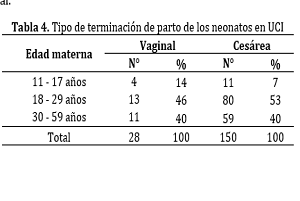Deaths and hospitalizations in a Peruvian Neonatal Intensive Care Unit
DOI:
https://doi.org/10.51252/rsayb.v1i2.393Keywords:
morbidity and mortality, health services, public health, NICUAbstract
Neonatal mortality is a health priority; to address it is necessary to expand service offerings with comprehensive and timely care. The objective of the research was to determine the relationship between mortality and hospital stay in a Peruvian Neonatal Intensive Care Unit. Basic type research, with a non-experimental, correlational, cross-sectional design. The population and sample consisted of 178 patients from the Intensive Care Unit; the survey technique was used and two questionnaires were used as instruments. Among the results, it is evident that the hospital stay in the Neonatal Intensive Care Unit is from 0 to 7 days, corresponding to 45%. The mortality of neonates according to hospital stay is 60% who died between 0 to 7 days when admitted to the Neonatal Intensive Care Unit. It was concluded that there is a moderate positive correlation between mortality and hospital stay with a Pearson coefficient of 0.8103, coefficient of determination (0.6567) that allows us to mention that 65.67% of the hospital stay affected mortality.
Downloads
References
Villa-Bahena S, Iglesias-Leboreiro J, Bernardez-Zapata I, Rendon-Macias ME, Acuna-Carrillo P, De Luna-Sanchez IG. Hospital mortality in a neonatal intensive care unit of a private hospital. Rev Mex Pediatr. 2021;88(1):5–9. Disponible en: http://www.scielo.org.mx/scielo.php?script=sci_abstract&pid=S0035-00522021000100005&lng=en&nrm=iso&tlng=en
Pérez Díaz R, Rosas Lozano AL, Islas Ruz FG, Baltazar Merino RN, Mata Miranda M del P. Estudio descriptivo de la mortalidad neonatal en un Hospital Institucional. Acta Pediátrica México. 2018;1(1):23. Disponible en: http://www.scielo.org.mx/scielo.php?script=sci_arttext&pid=S0186-23912018000100023&lng=es&nrm=iso
Montaño-Pérez CM, Cázarez-Ortiz M, Juárez-Astorga A, Ramírez-Moreno MA. Morbilidad y mortalidad en recién nacidos menores de 1,000 gramos en una institución pública de tercer nivel en México. Rev Mex Pediatr. 2019;86(5):108–11. Disponible en: http://www.scielo.org.mx/scielo.php?pid=S0035-00522019000300108&script=sci_arttext
Antunes de Araujo Filho AC, Dantas Almeida P, Lages de Araujo AK, Magalhães Sales IM, Evangelista de Araújo TM, Santiago da Rocha S. Aspectos epidemiológicos de la mortalidad infantil en un estado del Nordeste de Brasil. Enferm Glob. 2018;17(1):458–67. Disponible en: https://scielo.isciii.es/scielo.php?script=sci_arttext&pid=S1695-61412018000100448
Michel-Macías C, Rivera-Rueda MA, Fernández-Carrocera L, Carrera-Muiños S, Arroyo-Cabrales LM, Coronado-Zarco IA. Morbilidad y mortalidad de neonatos < 1,500 g ingresados a la UCIN de un hospital de tercer nivel de atención. Perinatol y Reprod Humana. 2017;31(4):163–9. Disponible en: https://www.sciencedirect.com/science/article/pii/S0187533718300311
Ballesté López I, Alonso Uría RM, González Ballesté M, Campo González A, Amador Morán R. Repercusión de la sepsis neonatal tardía en la morbilidad y mortalidad. Rev Cuba Obstet y Ginecol. 2018;44(1):1–9. Disponible en: http://scielo.sld.cu/scielo.php?script=sci_arttext&pid=S0138-600X2018000100009
Marrugo-Arnedo CA, Arrieta-Arrieta A, Herrera-Malambo D, Díaz-Vargas LC, Pérez-Yepes C, Dueñas-Castell C. Determinantes de estancia prolongada de neonatos en una unidad de cuidados intensivos. Rev Ciencias la Salud. 2019;17(2):259–75. Disponible en: https://revistas.urosario.edu.co/index.php/revsalud/article/view/7928
Aguilar García CR, Martínez Torres C. La realidad de la Unidad de Cuidados. Med crítica (Colegio Mex Med Crítica). 2017;31(3):171–3. Disponible en: http://www.scielo.org.mx/scielo.php?script=sci_arttext&pid=S2448-89092017000300171
Faraj Faria T, Kamada I. Lesiones de la piel en neonatos en cuidados intensivos neonatales. Enferm Glob. 2018;17(1):220–8. Disponible en: https://revistas.um.es/eglobal/article/view/273671
Segura Tosca R, Olmos Aguilera R, Blasco Bellido J. Causas de mortalidad neonatal en la Comunidad Valenciana. Med Fetal y Neotología. 2002;57(6):565–9. Disponible en: https://www.analesdepediatria.org/en-pdf-S1695403302787171
Ota A. Manejo neonatal del prematuro: avances en el Perú. Rev Peru Ginecol y Obstet. 2018;64(3):415–22. Disponible en: http://www.scielo.org.pe/scielo.php?script=sci_arttext&pid=S2304-51322018000300015
Hernández Sampiere R. Metodología de la investigación. Las rutas cuantitativa, cualitativa y mixta.
México: Mc Graw Hill Education; 2018. 714 p.
Chan LE, Reyes LG, Cahuana-Aparco J, Tejada-Llacsa PJ. Análisis de la mortalidad perinatal en Lima Norte: uso del método BABIES. Horiz Médico. 2019;19(2):19–27. Disponible en: https://www.horizontemedico.usmp.edu.pe/index.php/horizontemed/article/view/975
Vázquez Fernández ME, Sanz Almazán M, García Sanz S, Berciano Villalibre C, Alfaro Gonzales M, Ana DRL. Intervención Educativa en Atención Primaria para reducir y mejorar la educación de las consultas pediátricas. Rev Esp Salud Publica. 2019;93:1–12. Disponible en: https://scielo.isciii.es/scielo.php?script=sci_arttext&pid=S1135-57272019000100074&lang=es
Guevara Ríos E. La atención prenatal en tiempos de COVID-19. Rev Peru Investig Matern Perinat. 2020;9(3):6–7. Disponible en: https://investigacionmaternoperinatal.inmp.gob.pe/index.php/rpinmp/article/view/208
Chilipio-Chiclla MA, Atencio-Castillo KE, Santillán-Árias JP. Predictores perinatales de Apgar persistentemente bajo a los 5 minutos en un hospital peruano. Rev la Fac Med Humana. 2021;21(1):40–9. Disponible en: http://revistas.urp.edu.pe/index.php/RFMH/article/view/3345
Hernández Cabrera Y, León Ornelas ME, Díaz Puebla JL, Ocampo Sánchez A, Rodríguez Márquez A, Ruiz Hernández M. Caracterización clínica de pacientes con morbilidad materna extremadamente grave y su repercusión perinatal. Cienfuegos 2016-2018. MediSur. 2020;18(5):789–99. Disponible en: http://scielo.sld.cu/pdf/ms/v18n5/1727-897X-ms-18-05-789.pdf
Lorduy Gómez J, Díaz Beltrán G, Sandoval Dueñas E, Salinas Perea R, Ascencio Díaz K, Jiménez Gómez J. Factores pronósticos de mortalidad por agente infeccioso en un hospital de alta complejidad de Cartagena-Colombia. Rev Habanera Ciencias Médicas [Internet]. 2021;20(3):1–10. Disponible en: http://scielo.sld.cu/scielo.php?script=sci_arttext&pid=S1729-519X2021000300015

Published
How to Cite
Issue
Section
License
Copyright (c) 2022 Keller Sánchez-Dávila, Lolita Arévalo-Fasanando, Alicia Bartra-Reátegui, Carlos Alberto Torrejon-Pezo, Rosa Patricia Torres-Pinedo

This work is licensed under a Creative Commons Attribution 4.0 International License.
The authors retain their rights:
a. The authors retain their trademark and patent rights, as well as any process or procedure described in the article.
b. The authors retain the right to share, copy, distribute, execute and publicly communicate the article published in the Revista Salud Amazónica y Bienestar (RSAYB) (for example, place it in an institutional repository or publish it in a book), with an acknowledgment of its initial publication in the RSAYB.
c. Authors retain the right to make a subsequent publication of their work, to use the article or any part of it (for example: a compilation of their works, notes for conferences, thesis, or for a book), provided that they indicate the source of publication (authors of the work, journal, volume, number and date).



